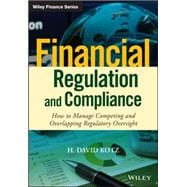Financial Regulation and Compliance provides detailed, step-by-step guidance for the compliance professional seeking to manage overlapping and new regulatory responsibilities. Written by David Kotz, former Inspector General of the SEC with additional guidance provided by leading experts, this book is a one-stop resource for navigating the numerous regulations that have been enacted in response to the financial crisis. You'll learn how best to defend your organization from SEC, CFTC, FINRA, and NFA Enforcement actions, how to prepare for SEC, FINRA, and NFA regulatory examinations, how to manage the increasing volume of whistleblower complaints, how to efficiently and effectively investigate these complaints, and more. Detailed discussion of the regulatory process explains how aggressive you should be in confronting federal agencies and self-regulatory organizations and describes how commenting on issues that affect your business area can be productive or not. The companion website includes a glossary of terms, regulations and government guidance, relevant case law, research databases, and FAQs about various topics, giving you a complete solution for keeping abreast of evolving compliance issues.
These days, compliance professionals are faced with a myriad of often overlapping regulatory challenges. Increased aggressiveness on the part of regulators has led to increased demand on financial firms, but this book provides clear insight into navigating the changes and building a more robust compliance function.
- Strengthen internal compliance and governance programs
- Manage whistleblower programs and conduct effective investigations
- Understand how to minimize exposure and liability from Enforcement actions
- Learn how to prepare for the different types of regulatory examinations
- Minimize exposure from FCPA violations
- Understand the pros and cons of commenting on regulations
The volume and pace of regulatory change is causing new and diverse pressures on compliance professionals. Navigate the choppy waters successfully with the insider guidance in Financial Regulation and Compliance.








